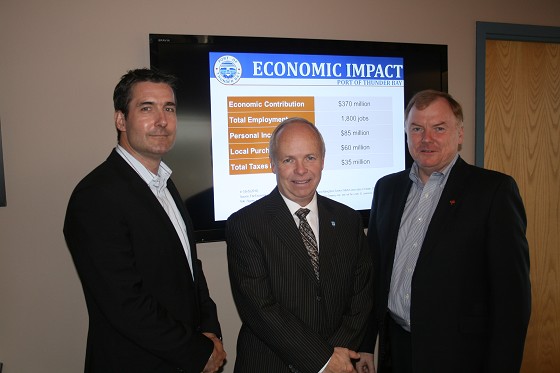Port of Thunder Bay Has A Big Economic Impact
by Scott A. Sumner
The Port of Thunder Bay was part of a major economic study released recently showing just how important the water transportation system is to our economy. The annual economic impact of the port is $370 million and there are 800 direct jobs in port facilities in terms of
labourers, stevedores, grain inspectors and all of the maritime services provided. There are another 1000 indirect jobs related to the Port of Thunder Bay. The property taxes paid are the largest industrial base in the city of Thunder Bay and in excess of $10 million per year.
“ The study we are releasing today really quantifies the value of the port to the economy in the area. It is one of the reasons the study was done. We had a study done 20 years ago but it has been quite some time since we updated it. Also this is the first time the seaway in its entirely has been studied so it will be a useful tool to highlight the economic benefits,” said Tim Heney, CEO of the Thunder Bay Port Authority. “ The port has an interesting history. We were the largest grain port in the world but are still the largest grain storage area in North America and have huge potential for economic spin off. For example the economic spin off of one cargo ship coming into Thunder Bay is $150,000 right into the local economy. This includes the trucking
companies that come to town, the stevedores and the fabricators. It is very labour intensive.”
Things have looked good in 2011 for the Port of Thunder Bay. “ We have one of our better years certainly in the last three and project cargo is the best ever. We are up 12% on the overall port cargo and 20% on grain.” said Heney.
Also exciting at the Port of Thunder Bay is a new crane acquisition. “ We have just bought a new crane from California. It will be the largest crane on the Great Lakes and the largest single crane located west of Montreal. It will provide a lot of new opportunities for us in terms of different types of cargo. It is a state of the art german made machine and will lift 104 tons from the centre of a ship so it has some pretty good capabilities,” said Heney. “ We have been deficient in not having an on site crane here before but this is now being corrected. The crane is currently in Stockton, California. We purchased it from a company that had never installed it. It is a 2008 brand new crane. It will be a major rail move here and will be coming here in the spring.”
One of the speakers at the port event was Ray Johnston, President of Chamber of Marine Commerce based in Ottawa. The organization has about 150 members of which the Port of Thunder Bay is one of them. The members include all the ports across Canada, shippers who use the services, the shipping companies and the St Lawrence Seaway. It is a broad based organization of grain industry stakeholders.
A major issue of concern for the organization is the upcoming ballast water regulations that the State of New York plans to introduce in 2013. There is an international standard already but New York is putting in to place regulations that are 100 to 1000 times more stringent than the international standard. “ Any ship that comes to Thunder Bay has to pass though New York waters. The standard is technologically unachievable. There is no technology or equipment than can achieve the standard they are suggesting. They feel that ballast water is an invasive species than can be a problem but there are studies that the current practice known as ballast water flushing overseen by agencies had been working since 2006.” said Ray Johnston. “
Our economic study allowed us to quantify the impact of $10 billion lost economic contributions and 70,000 jobs lost if the regulations go into effect. We want people to understand that we currently have a ballast system that is working. The overall study shows a $35 billion economic impact to the provinces and states than border the waterway and 225,000 jobs. We have to solve the New York issue which is coming to a head in the next 14 months.”
Overall the shipping industry on the Great Lakes has been improving. “ In the last year the tonnages have recovered to pre recession levels with optimism for the future. The big news is the investment in new ships. There were no new ships built for over 25 years here but right
now there is over $ 1 billion committed in the next three years for ships to trade in the waterway. Ports like Thunder Bay are investing in infrastructure as well.” said Johnston.
John Heimbecker is the Vice President of Parrish & Heimbecker, a Canadian agri business or grain company based in Winnipeg with one elevator in Thunder Bay. The company is 103 years old and been in Thunder Bay since 1913. They also have terminals in Owen Sound,
Goderich and Hamilton and elevators across Western Canada with two terminals in Vancouver.
“ The Canadian Wheat Board is being reviewed and abolished from the monopoly on August 1 2012. It was a decision of the government and we were fine working with the old system of the Wheat Board and will be fine working in an open market environment. The grain companies haven't been permitted to trade wheat and barley since 1935 so we are gong to do that now,” said Heimbecker. “ The grain industry in Canada and world wide is up because of the demand. Canada has had good years in a row with good supply. Canadian grain trades everywhere in the world including Africa, India, Pakistan, China and Japan. When the market changes we will have a bigger opportunity to use our assets on the St Lawrence easier with the free market system, going through Thunder Bay.”










